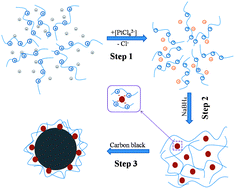Stabilization of platinum nanoparticle electrocatalysts for oxygen reduction using poly(diallyldimethylammonium chloride)
Abstract
A long-chain polyelectrolyte, poly(diallyldimethylammonium chloride) (PDDA), has been employed to stabilize

* Corresponding authors
a
Shcool of Chemical Engineering & Technology, Harbin Institute of Technology, Harbin, China
E-mail:
yingphit@hit.edu.cn
b
Pacific Northwest National Laboratory, Richland, WA, USA
E-mail:
yuehe.lin@pnl.gov
A long-chain polyelectrolyte, poly(diallyldimethylammonium chloride) (PDDA), has been employed to stabilize

 Please wait while we load your content...
Something went wrong. Try again?
Please wait while we load your content...
Something went wrong. Try again?
S. Zhang, Y. Shao, G. Yin and Y. Lin, J. Mater. Chem., 2009, 19, 7995 DOI: 10.1039/B912104H
To request permission to reproduce material from this article, please go to the Copyright Clearance Center request page.
If you are an author contributing to an RSC publication, you do not need to request permission provided correct acknowledgement is given.
If you are the author of this article, you do not need to request permission to reproduce figures and diagrams provided correct acknowledgement is given. If you want to reproduce the whole article in a third-party publication (excluding your thesis/dissertation for which permission is not required) please go to the Copyright Clearance Center request page.
Read more about how to correctly acknowledge RSC content.
 Fetching data from CrossRef.
Fetching data from CrossRef.
This may take some time to load.
Loading related content
